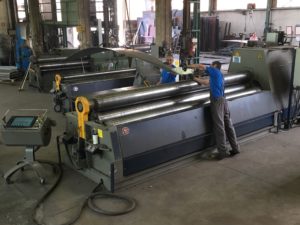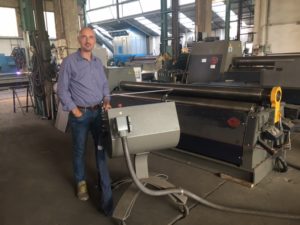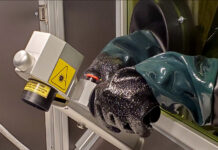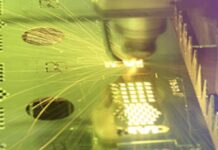The successful case of a small company, in the sheet metal industry, which has succeeded in managing the bureaucratic confusion of the national plan for industry 4.0 and has efficiently integrated new manufacturing technologies.
 History tells us that the Industrial revolution was a process of economic evolution that has gradually led to the industrialization of society, which from an agricultural-craft system has shifted into a modern system characterized by the use of machines powered by mechanical energy and by the use of new energy sources. History books often refer to a First and a Second Industrial Revolution. The first mainly concerned the textile-metallurgic sector with the introduction of steam machines in the second half of the Eighteenth Century. The Second Industrial Revolution, in the last decades of the Nineteenth Century, is accomplished thanks to the introduction of the electricity, of chemical products, of oil and, especially, due to the improvement of fusion techniques that give birth to steel. A Third Industrial Revolution is mentioned in Western Countries in the second post-war period, too, which originates from the war challenge among superpowers during the Second World War and goes on with the arms race that characterized the Cold War and the competition to conquer the space in the decade from the Sixties to the Seventies, when the use of the first computers grows. The phenomenon of data exchange and analysis in real time, the almost unlimited possibility of Internet connection, of low cost wireless connection, of digitalized support, the use of forefront Information and Communications Technology (ICT), which is expressed by digital instruments, software programmes and telecommunications, today redefines the way of operating of a company. We live in a world where information are more and more numerous and it becomes increasingly important to manage this volume of notions efficiently and quickly. Precisely for this reason, ICT are the instrument to manage qualitatively better data in the ambit of the business organization and, thanks to the diffusion of technology and inter-connectivity, companies can redefine their operation modalities and the relationships with customers. Today the capability of filing, handling, designing and recovering data redefines and characterizes an activity, whatever it is. In the opinion of the Minister for the Economic Development, Carlo Calenda, the package Industry 4.0, will support companies in enhancing their competitive edge, through investments: it will determine the economic recovery. The Minister has in fact announced the advent of a significant package of investments and new financial provisions to support this technological progress and to let Italian companies become more competitive in the world market. Besides, they have introduced the so-called «super-amortization» with specific reference to capital goods with high technological contents. In short, subsidies for companies that will invest in new production systems, new machinery, new functional equipment that will support human work. Italian industries are immediately benefitting from this initiative and they try to operate in the new scenario exploiting at best the technology they already own, software programmes, management software, automation and they try to go beyond. Italians are not afraid of undertaking new initiatives and of investing, on the contrary, the opportunity of these financial aids has been welcomed, even if not with childish enthusiasm, with due attention and has generated expectations for the future that will result, for many enterprises, in the upgrading of the machine fleet and of the technological background that supports their production. The target is becoming more competitive on the market, optimizing production processes and diversifying solutions according to demands. To tell the truth, it is not easy indeed to operate, when funds and tax reductions are at stake Italians are never given the due instructions. To make a literary comparison, this recalls the image of the white rabbit in the novel by Lewis Carroll, Alice’s Adventures in Wonderland published for the first time in 1865. The personage, translated into Italian with the name Bianconiglio, passes indifferently in front of the protagonist, Alice, and runs. The white rabbit indicates an unexpected event that leads to a superior reality, which breaks up one’s own conventions in a move. Following the white rabbit means to pay attention to what can happen fully unexpectedly and to be able to react. The relativity of time and things is one of the issues of the book. What is right and what is wrong. What path guides us back home and what leads to the Queen of Hearts who cuts our head. The White Rabbit is in a hurry, he does not wait, he does not talk with us, we are like Alice, we must stand up and move, we cannot ask questions, just follow him. Well, the bureaucracy that rules this paradigm, in fact, is hardly understandable and the course is full of quibbles and documents to decipher, in order to understand whether we comply with its parameters or not. Significant is the choice of a company that has found the right path.
History tells us that the Industrial revolution was a process of economic evolution that has gradually led to the industrialization of society, which from an agricultural-craft system has shifted into a modern system characterized by the use of machines powered by mechanical energy and by the use of new energy sources. History books often refer to a First and a Second Industrial Revolution. The first mainly concerned the textile-metallurgic sector with the introduction of steam machines in the second half of the Eighteenth Century. The Second Industrial Revolution, in the last decades of the Nineteenth Century, is accomplished thanks to the introduction of the electricity, of chemical products, of oil and, especially, due to the improvement of fusion techniques that give birth to steel. A Third Industrial Revolution is mentioned in Western Countries in the second post-war period, too, which originates from the war challenge among superpowers during the Second World War and goes on with the arms race that characterized the Cold War and the competition to conquer the space in the decade from the Sixties to the Seventies, when the use of the first computers grows. The phenomenon of data exchange and analysis in real time, the almost unlimited possibility of Internet connection, of low cost wireless connection, of digitalized support, the use of forefront Information and Communications Technology (ICT), which is expressed by digital instruments, software programmes and telecommunications, today redefines the way of operating of a company. We live in a world where information are more and more numerous and it becomes increasingly important to manage this volume of notions efficiently and quickly. Precisely for this reason, ICT are the instrument to manage qualitatively better data in the ambit of the business organization and, thanks to the diffusion of technology and inter-connectivity, companies can redefine their operation modalities and the relationships with customers. Today the capability of filing, handling, designing and recovering data redefines and characterizes an activity, whatever it is. In the opinion of the Minister for the Economic Development, Carlo Calenda, the package Industry 4.0, will support companies in enhancing their competitive edge, through investments: it will determine the economic recovery. The Minister has in fact announced the advent of a significant package of investments and new financial provisions to support this technological progress and to let Italian companies become more competitive in the world market. Besides, they have introduced the so-called «super-amortization» with specific reference to capital goods with high technological contents. In short, subsidies for companies that will invest in new production systems, new machinery, new functional equipment that will support human work. Italian industries are immediately benefitting from this initiative and they try to operate in the new scenario exploiting at best the technology they already own, software programmes, management software, automation and they try to go beyond. Italians are not afraid of undertaking new initiatives and of investing, on the contrary, the opportunity of these financial aids has been welcomed, even if not with childish enthusiasm, with due attention and has generated expectations for the future that will result, for many enterprises, in the upgrading of the machine fleet and of the technological background that supports their production. The target is becoming more competitive on the market, optimizing production processes and diversifying solutions according to demands. To tell the truth, it is not easy indeed to operate, when funds and tax reductions are at stake Italians are never given the due instructions. To make a literary comparison, this recalls the image of the white rabbit in the novel by Lewis Carroll, Alice’s Adventures in Wonderland published for the first time in 1865. The personage, translated into Italian with the name Bianconiglio, passes indifferently in front of the protagonist, Alice, and runs. The white rabbit indicates an unexpected event that leads to a superior reality, which breaks up one’s own conventions in a move. Following the white rabbit means to pay attention to what can happen fully unexpectedly and to be able to react. The relativity of time and things is one of the issues of the book. What is right and what is wrong. What path guides us back home and what leads to the Queen of Hearts who cuts our head. The White Rabbit is in a hurry, he does not wait, he does not talk with us, we are like Alice, we must stand up and move, we cannot ask questions, just follow him. Well, the bureaucracy that rules this paradigm, in fact, is hardly understandable and the course is full of quibbles and documents to decipher, in order to understand whether we comply with its parameters or not. Significant is the choice of a company that has found the right path.
The protagonists of the story
Franchino s.r.l. relies on a long experience in metalworking. Established in 1957, the brothers Dario, Elio and Aldo Franchino, encouraged by the economic boom of those years, start operating in the sheet metal cutting and bending. They start collaborating with important poles like Fiat and Indesit, and soon in their offices and factories at Orbassano, in the Turin area, the raw sheet metal becomes a manufactured good through processes such as roll bending, section bending, oxygen cutting, cutting and bending, plasma cutting and water-jet cutting. The second generation, represented by Fabrizio and Ezio, continues their fathers’ policy but they extend their range of action to all sectors of steel structural works, automotive and building industry. Today the company supplies iron, stainless steel and aluminium products, thanks to its noteworthy machine fleet that includes blanking and bending departments, oxygen and plasma cutting plants, water-jet cutting, bending machines and section benders. Its sister company Franchino Rivestimenti has been operating for 15 years now and offers a complete aluminium anti-wear upholstering system for commercial vehicles granting them full protection. In Cuneo province, in Fossano, MG s.r.l. is a manufacturer of plate rolling machines, section benders and, for some years, of plate straighteners, too. MG machines enable companies like Franchino s.r.l. to implement their products. Even if MG has a sales office for Italy at Santa Maria Nuova, in the outskirts of Forlì, MG and Franchino have the typical Piedmontese character, they are not very talkative and they do not boast what they do but they reap the fruits of their experiences and they try to give a concrete and economically valid answer, offering competence and professionalism. On the market since 1959, and since 1981 specialized in the design of hydraulic plate rolling machines and section bending machines, MG manufactures machines with working length from 200 mm to 8000 mm, and able to bend thicknesses from 0.2 to 300 mm. The owners of MG, Massimo Roccia, Francesco Barca and Giorgio Giraudo, are convinced that nowadays a company must be flexible, must not focus on a single product typology and must not standardize its manufactured items but instead it should provide customized solutions. Massimo Roccia comments: «Today more than ever, it is essential to stand out and to diversify one’s own production, to satisfy all plate rolling requisites, for each customer».
The machines of the turning point
Franchino s.r.l has purchased two models of plate bending machines of PH type. PH are plate bending machines with 3 powered rolls with variable axes, where the upper roll moves on its vertical axis and behaves like a press, getting in contact with the side rolls that move instead on the horizontal axis. PH models were conceived some years ago precisely as alternative to the conventional 4-rolls. The advantage is that lateral rolls can approach the upper one considerably and this helps when bending pieces with minimum blank. PH is a very versatile type of plate bending machine, it bends extremely small diameters on big thicknesses and is suitable for the machining of conical or even eccentric shapes. One of the bought models, PH 2.240, will work thicknesses of 45 mm on a length of 2100 mm, the second, PH 3.600, on a length of 3100 mm, will bend 70 mm with a thrust of 600 tons. Ezio Franchino comments «It is not simple to move in the bureaucratic labyrinth, you must always pay utmost attention, you must be present wherever there are possibilities of attaining facilitations». Moreover «With them, I upgrade part of my machine fleet and I join a funding programme that provides not only for the technological progress but also the work safety, allowing my operators to stay more distant from the machine and to control the operation in remote». The two PH are equipped with a Numerical Control developed by Delsy, MG software sister company, headed by Daniele Albenga. Touch Command EVO has touchscreen and it is user friendly and intuitive. Thanks to its versatility, EVO allows the wireless communication, the interconnection, the data collection and analysis in real time as well as the visualization of the desired shape in 3D graphics. Simply touching the screen, also with work gloves, the operator can input the plate parameters and the control will generate the programme to bend it. Otherwise, the operator can personally create the bending programme that afterwards the CNC will execute automatically. The system learns the coordinates that are automatically executed with the highest accuracy and automatically corrects any deviation. Plate batches theoretically equal one another can have actually different characteristics and provide not uniform bending results. To solve that, EVO performs a plate test in very short time and with very scarce use of material, which leads to excellent results already at the first tested piece. In multiple diameter machining, the speeds of interpolated motions are selected fully automatically and are controlled in all stress and temperature conditions and in real time during the roll bending process, thanks to the «close-loop» system that allows the simultaneous verification of the productive process at any time. If, while machining, the roll starts deviating from the input position, the rotation will increase or will slow down automatically to assure that the plate bending occurs correctly. The process is always visualized on the screen. Besides, the possibility of mounting a micro camera on the openable support of the machine focused on the bending point allows the operator to visualize the result on an additional monitor, too. EVO carries out the investigation of the machine status and indicates the eventual need of executing maintenance interventions to grant always the best functionality. The automatic measuring of the bending radius can be detected externally through the use of the electronic arc meter, still manufactured by MG/Delsy, which sends data to the CNC itself through Wi-Fi connection. Plate loading and unloading systems, with sensors that signal the presence of pieces, as well as lateral and vertical supports, can be interpolated with EVO for the creation of a fully automated production system. The remote service system allows the connection of the MG operator with the machine for the troubleshooting. In addition to all that, MG, in cooperation with Delsy, is developing a laser system for measuring big-size radii. Worth highlighting then, they are already working at the new EVO. This leads the plate bending process to acquire an overall «augmented» identity. Interconnected devices, numerical control, instruments that dialogue one another and exchange an enormous amount of data in very short time, what sector experts have defined the Internet of Things. However, those who know MG and Franchino are aware that they will never use this term, they know that man will always be the core of technology for them.
The success resides in the force of innovating
MG and Franchino know what they want and they intend to pursue, i.e. supplying their customers with the best and most suitable solution or product for a determinate need and a certain time, thus allowing customers to be competitive on the market. MG accepts a new challenge when it starts designing straightening machines. These machines make a sheet metal that features bends and imperfections perfectly smooth, so that it can be used as top-quality material. Massimo Roccia comments: «Last month we won an international contract for the supply of a straightening machine that will work titanium with 75 mm thickness for an important buyer in Saint Petersburg. It was a fine challenge to take part in this competition and Russians are demanding people, they ask lots of information and expect various guarantees. Competitors were many, even if such a machine does not involve a standard design; besides, we were already requested to provide an overall study and a project estimate, not easy, but we were trustworthy». For some time now, MG has already manufactured 4-rolls section benders and is designing a new 6-rolls section bending machine for an American customer. Massimo adds: «If you do not accept challenges you are no longer competitive, if you remain in your comfort zone, today you cannot reach what makes you really special, what people definitively are looking for». Franchino SRL is aware that in Italy there are few subcontracting companies able to perform these machining operations and besides, it can rely on 60 years of gained experience. The highest efficiency, coupled with an adequate organization, lets the company succeed in satisfying customers’ most different requirements, from small to big enterprises. The new PH will replace two obsolete machines, the new job orders will be managed more rapidly and efficiently. «We have a lot of work and this encourages us to go on, it is essential to be able to propose ourselves» – Further states Ezio, «To tell the truth, neither in crisis time we were idle. Today we are working at full rate, sometimes also relying on overtime hours, I am optimistic». Without the will of entrepreneurs, of men like them, all this would be impossible. Massimo, Franco, Giorgio, Ezio and Fabrizio. They are simple, true people, their look expresses what they feel. Constantly researching, they will pursue the best thing, in that precise time, for that customer, and they will use the best possible technology for that case. A friendly smile, a shake of hands will always be their business card. What will their sons think in the future? What will their grandsons think of their companies and of their choices? It is not possible for us to know, meanwhile they are chasing the White Rabbit.










